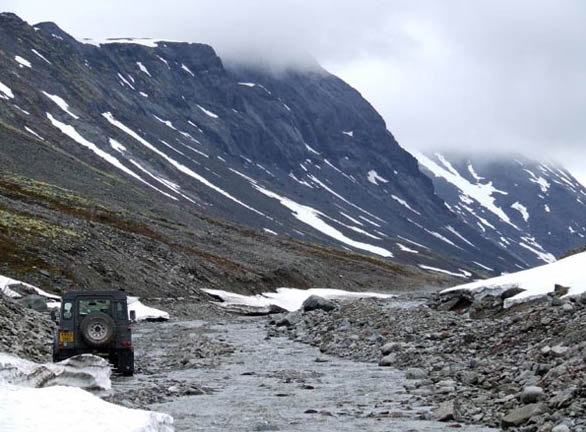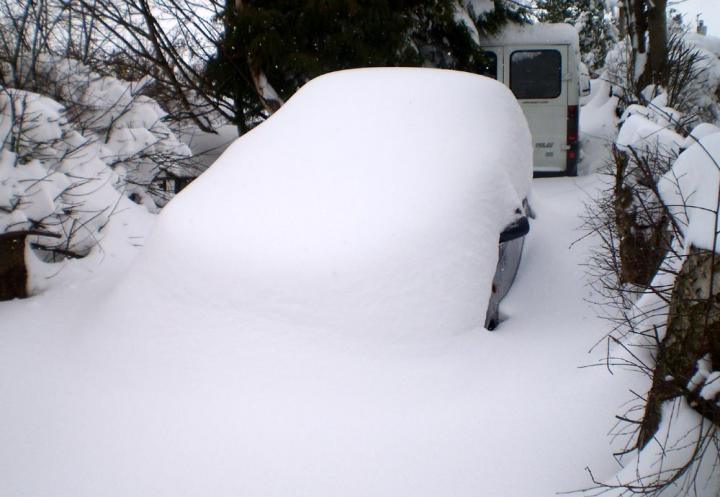OVERLAND PREPARATION

Above: Arctic Russia. Photo: Robb Pritchard on World 4x4 Adventures' Arctic Tour (www.world4x4.co.uk)
The Editor advises you to be well-prepared if you are off-roading in the snow… Whether it’s in Arctic Russia or the UK in Winter
There are basically three levels of preparation:
1: Your Vehicle.
2: The Crew.
3: The Unexpected.
1: VEHICLE PREPARATION
Taking the vehicle first, assuming you have a 4X4, your antifreeze strength should be checked and the level topped (which should be undertaken throughout the year). Often, especially if your vehicle is susceptible to coolant loss, during the nice warm days of summer (and this year, autumn), it’s often easier to top up the radiator with tap water and not the recommended levels of antifreeze, so when the antifreeze in really needed, it can be considerably diluted. Been there, cracked the waterpump, not the block luckily!
So, you need to check the strength as soon as possible and get it topped up with the correct concentration of antifreeze, even if it means draining off some of the mixture already in the cooling system. If you need to change the thermostat (or add one!), this is a good time to do it as you’ll loose coolant when you remove the thermostat housing.
Your windscreen washer bottle should have WINDSCREEN antifreeze added, which is NOT the same as the antifreeze you use in your cooling system, unless you want to discolour or remove the paint where your jets are directed!
Make sure you follow the instructions on the bottle in both cases. If your windscreen wiper blades need changing, now is a good time to do so. You can find screenwash antifreeze that will protect you to -40 degrees centigrade, which is useful if driving in Siberia or the Rockies, but you’ll have to look hard for it>
The battery is likely to receive heavier abuse than usual, so now is the time to to replace it if it’s on the way out. If it’s still healthy, at least get it fully charged up. If you use an electric winch on your vehicle and it’s powered by the engine battery, you might consider added one for winch use only and using a split charge system. I have a solar charger in my vehicle which will keep the battery topped up unless it has had hard use.
If you’re not using multigrade oil, it’s now the time to change to a lighter oil for the winter – check with your owner’s manual for the type you need.
Heating and windscreen demisting is important this time of year, so if your heater needs and overhaul or upgrading, now is the time to visit the scrapyard or log on to ebay and get the necessary work undertaken. (For example, you can upgrade a Series Land Rover with one from a 90 or 110.
There are additional 12 volt heater fans you can buy from accessory shops that will assit in heating up the cab, but obviously the smaller the cab the better they work. At least they are handy for warming your hands and other important extremities.
If your vehicle is equipped with a winch, its regular greasing/oiling and inspection should be undertaken and it should be engaged to seee if everything works. Better to sort problems in a workshop than on a snow-covered moor. Whilst you are testing your winch, add freewheel hubs, high/low ratios, brakes, etc to the list of things to check. Don’t forget your lights. And make sure your difflock engages – one my old Range Rover Tdi, it wasn’t even connected!
Tyres are another consideration. What condition are they in? You do check them every week, don’t you? If you don’t, check them now. Make sure pressures are correct and the tread is legal. If you’re using road tyres, you may consider investing in a set of mud terrains (or at least All-Terrains) – perhaps a set of five on rims that can just be swapped over, then swapped back when the warmer weather reappears.
Another essential is your toolkit. Apart from the obvious spanners and screwdrivers, my box conatins all those useful items – clips, repair tapes, nuts and bolts, wire, and a plethora of other ‘useful’ items. Other things I add to it in the winter period are de-icer, an ice-scraper and, in the vehicle itself, a snow shovel. This was an item I purchased in France whilst taking part in the Crossiere Blanche – a randonee in the High Alps. The shovel works just as well in North Wales! I also have a couple of cheap tarpaulins, acquired from a ‘pound shop’, which are useful for all sorts of things, especially lying under the vehicle. A pair of jump leads and a can of WD40 or equivalent are two essentials carried at all times. You canm also start at fire by shorting two wires across the battery, handy if you haven’t any matches or they are wet. make sure there’s no uncontained fuel around when you do it.
Other winter essentials are a sleeping bag per person – it’ll keep you warm if you’ve broken down; a stove for cooking, a pan and the food to cook in it. I carry a couple of the ‘ready’meals’ you can purchase from outdoor shops, as they are easily warmed up in a pan of hot water, or on the engine. Don’t forget something to light the stove with. You can usually get 10/12 disposable lighters from a ‘pound shop’ – unlike matches they’ll operate when damp.. And see above re shorting the battery, safely…
Other useful items include a CB radio, a torch and spare rechargeable batteries, a Thermos flask with a hot drink in it, a container of water, compass, maps, axe, mobile phone + charger, snowchains, flares and a floodlight. I also carry a selection of recovery ropes and shackles, but I carry those all year, anyhow.
2: CREW PREPARATION
When selecting clothing, think layers. Wearing clothes in layers means it’s easy to add or subtract clothing as weather conditions improve or deteriorate. I normally start with thermal underwear, then a T-shirt and ex-Army trousers, followed by two wool pullovers topped with a water resistant fleece and bodywarmer, along with waterproof over-trousers, depending on outdoor temperatures. If, like me, your head has been converted into a rain/snowflake detector or a solar panel for a sex machine, then a covering is essential, as body heat loss can be 65%, with hands and feet being another area of high heat loss, so good socks, boots and gloves are another necessity. If you’re going for a day trip, have a good warm breakfast before you leave.
3: THE UNEXPECTED
No matter how well you prepare, there’s always something that can go wrong and, when it does, it can be in a big way. Don’t travel alone, if you can help it and don’t forget to tell someone your plans – even telephoning them if you change them. It’s a lot easier these days with a lot better mobile coverage. At least, if you do get lost, the search and rescue teams will have a rough idea which area to start searching in.
If you breakdown, especially in a snowstorm, stay with your vehicle(s), as it is a lot easier to spot a vehicle than a person in snow conditions. Your vehicle will also offer shelter, even if the engine isn’t running. Talking of engines running, if you are keeping the engine running to stay warm, don’t forget to leave a window slightly open, as you don’t want to sucumb to carbon monoxide poisoning.
If the snow level is above the vehicle, ensure a breathing hole is kept free, but using something to make an upwards hole (umbrella?). If you are able to tow the broken down vehicle, try to get to an area with trees as this will shelter you from cold winds and assist in keeping the temperature up – even half a degree might make the difference between survival and otherwise.
Don’t forget to read our article on Hypothermia, Dehydration and Frostbite...

Above: Yes, there's a Subaru Impreza under there. North East Wales March 2013.
You don't have to go to Siberia for snow... and that WAS UNEXPECTED... The weather forecast stated 5 inches of snow, then rain. We had 15 inches, then the same again...